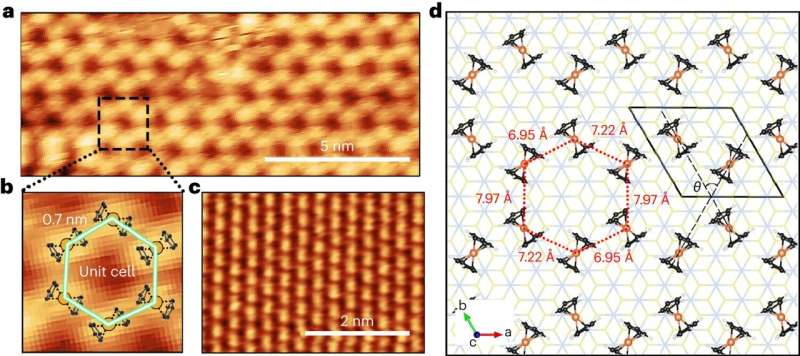This article has been reviewed according to Science X's editorial process and policies. Editors have highlighted the following attributes while ensuring the content's credibility:
fact-checked
peer-reviewed publication
proofread
Room-temperature long-range ferromagnetic order realized in a confined molecular monolayer

How can we manipulate intermolecular exchange interaction to achieve long-range spin ordering? The answer to this question is of great importance in understanding and modulating magnetic behavior at the microscopic scale and in developing new macroscopic magnetic materials and devices.
However, temperature and environment play a decisive role in molecular magnetic behavior and spin ordering. At high temperatures, thermal uplift disrupts the spin ordering and disables intermolecular exchange interactions.
According to the Mermin-Wagner theory prediction, there is no long-range spontaneous magnetic ordering in two-dimensional systems. Therefore, realizing two-dimensional room-temperature ferromagnetic molecular materials still remains to be a challenge in this field. If solved, it will be vital not only for a fundamental understanding of the nature of magnetism but also for opening new avenues towards a new magnetic material platform.
To address this issue, a research group led by Prof. Wu Changzheng from the Key Laboratory of Precision and Intelligent Chemistry of the University of Science and Technology of China (USTC) constructed room-temperature long-range ferromagnetic order and fabricated a molecular monolayer of honeycomb-like cobaltocene (Co(Cp)2), a simplified form of Co(C5H5)2) in a confined van der Waals interlayer space.
Researchers developed the vibronic superexchange interaction between Co(Cp)2 molecules and S atoms based on the dynamic charge transfer at the organic-inorganic (Co(Cp)2/SnS2) superlattice interface, and realized a long-range ferromagnetic order between organic molecules, from which they obtained the two-dimensional ferromagnetic molecular layers at high transition temperature (> 400 K) and large saturation magnetization (4 emu.g-1) in a weak field.
Researchers also managed to characterize the orientation of individual Co(Cp)2 molecules confined between SnS2 layers and structural assembly of honeycomb-like monolayer molecule by scanning probe microscopy coupled with scanning tunneling microscopy and atomic force microscopy.
The electron clouds of neighboring Co(Cp)2 molecules merged with each other to form delocalized electrons, which meditated the spin-exchange interactions between Co(Cp)2 molecules.
The research results were published in Nature Physics.
This work realizes a new structure of magnetic solids by modulating the molecular spin order, which is expected to provide better solutions for applications such as electronics, information storage and quantum computing.
More information: Yuhua Liu et al, Room-temperature long-range ferromagnetic order in a confined molecular monolayer, Nature Physics (2024). DOI: 10.1038/s41567-023-02312-z
Journal information: Nature Physics
Provided by University of Science and Technology of China





















